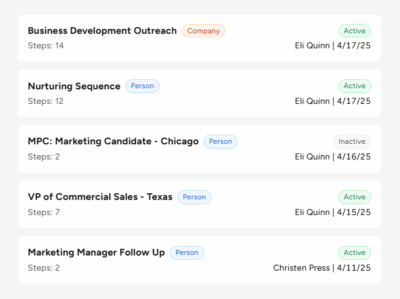As a recruiter, managing your time and resources efficiently is key to success. Despite best intentions, it’s easy to get caught up in unproductive activities that don’t contribute to your goals. According to a survey by Inc., the average worker wastes about 21.8 hours each week, often through activities like unnecessary emails, social media distractions, and unscheduled interruptions. For recruiters, improving productivity requires recognizing these inefficiencies and adopting best practices for effective time management.
In this article from Top Echelon Recruiting Software, we’ll explore how to maximize your recruiting efficiency as a search consultant.
Identifying and Eliminating Common Time Wasters
Before diving into productivity strategies, it’s essential to identify common time-wasting activities that may be hampering your efficiency as a recruiter. While checking emails or taking quick mental breaks might feel necessary, they can consume a significant portion of your day if not managed properly. According to the Inc. survey, three major time-wasters include:
- Non-work-related online activity – Browsing social media, checking news, or other “mental health breaks” can add up to hours of lost time each week.
- Unnecessary emails – Constantly checking and responding to low-priority emails interrupts your workflow.
- Interruptions from colleagues or external sources – Frequent interruptions can cause you to lose focus, making it harder to return to important tasks.
Recognizing these distractions is the first step toward managing them. Once you identify the sources of lost productivity, you can implement strategies to keep them under control.
Best Practices to Improve Productivity
Boosting productivity isn’t just about getting more done; it’s about working smarter. Here are seven best practices to help you become more efficient and effective in your recruitment process:
1. Adopt the Pomodoro Technique
The Pomodoro Technique is a simple time-management method that involves working in 25-minute bursts with 5-minute breaks in between. After completing four “Pomodoros,” you take a longer break, typically 15–30 minutes. This structured approach helps maintain focus while providing enough time for short mental breaks, ensuring that you don’t burn out during long stretches of work.
To make this method even more effective, use a browser extension or app that tracks your Pomodoros and helps you schedule these intervals seamlessly into your day.
2. Learn to Say “No”
One of the most overlooked productivity strategies is learning when to say “no.” As a recruiter, it’s tempting to take on every task that comes your way, but doing so can lead to overcommitment and burnout. Prioritize tasks that directly align with your goals, and don’t be afraid to decline requests that don’t contribute meaningfully to your core responsibilities.
Saying no to additional work can help you focus on high-priority activities like sourcing candidates, interviewing, or building client relationships.
3. Delegate Responsibilities
It’s easy to fall into the trap of thinking you have to do everything yourself, but delegating tasks to team members can save time and boost productivity. Identify routine tasks—like data entry or setting up interview times—that can be handed off to others. By training your team to handle these responsibilities, you free up time to focus on more critical activities, such as client negotiations or sourcing top-tier talent.
Make sure to provide adequate training to team members to ensure they can take on the delegated responsibilities efficiently.
4. Create Detailed To-Do Lists
Creating to-do lists is one of the simplest yet most effective productivity strategies. Break down your tasks into smaller, more manageable parts and set realistic goals for each day. Prioritize the tasks that must be completed, and track your progress.
A detailed to-do list also allows for easier delegation, as you can better identify which tasks can be passed on to others. There are numerous digital tools, such as Trello or Todoist, that can help you organize your daily and weekly goals.
5. Set Time Blocks for Emails
Email management is one of the biggest productivity killers. The average worker spends 28% of their workweek on emails, according to a study by the McKinsey Global Institute. To avoid being constantly interrupted by emails, designate specific times during the day to check and respond to them. For instance, handle emails first thing in the morning, during lunch, and at the end of the day.
Limiting email checks reduces distractions and keeps your workflow uninterrupted for longer periods, allowing for more focused and productive work sessions.
6. Set Personal Deadlines
Even if certain tasks don’t have hard deadlines, it’s important to set your own. Without deadlines, tasks can be left unfinished or pushed to the side. By giving yourself a firm timeline for each task, you create a sense of urgency that can improve focus and efficiency. Holding yourself accountable is key to ensuring tasks are completed in a timely manner.
7. Take Regular Breaks
Working non-stop can lead to burnout and reduced productivity. According to a study by the Draugiem Group, workers are more productive when they take short breaks throughout the day. A 5-minute break every hour or a 30-minute break every two hours allows you to recharge your mind and body, helping you stay sharp throughout the day.
Just be sure to set timers for your breaks so they don’t extend beyond their intended length.
Using an ATS to Streamline Your Workflow
An Applicant Tracking System (ATS) can significantly enhance your productivity by automating routine tasks and streamlining the recruitment process. Here are six ways an ATS can help improve your efficiency:
1. Customizable Workflows
ATS platforms allow for fully customizable workflows that are tailored to fit your recruitment process. This ensures that each step—whether it’s scheduling interviews or screening candidates—is optimized for speed and efficiency, helping you stay on track.
2. Automation of Recurring Tasks
Daily tasks like sending follow-up emails or scheduling interviews can be automated within an ATS. Automating these responsibilities frees up time to focus on more critical activities, such as sourcing high-quality candidates or building client relationships.
3. Integration of Third-Party Tools
An ATS can integrate with other tools such as email clients, calendars, and job boards. These integrations allow you to manage multiple aspects of the recruitment process from a single platform, reducing the time spent switching between different apps.
4. SMS Messaging
SMS messaging within an ATS allows for quick and direct communication with candidates. Text messages are more immediate and have higher open rates than emails, with 45% of candidates responding to texts. This ensures faster communication and quicker placement.
5. Searchable Candidate Database
A searchable candidate database helps you identify qualified candidates quickly. Instead of manually sifting through resumes, an ATS allows for granular searches based on experience, skills, and qualifications, helping you find the perfect candidate in less time.
6. Calendar Sync and Meeting Scheduling
Scheduling interviews can be one of the most time-consuming tasks for recruiters. ATS platforms often come with built-in scheduling tools that sync with your calendar, making it easier for candidates to select interview times that work for them.
Digital Tools to Boost Productivity
Beyond an ATS, there are several digital tools that can help you stay productive throughout your workday. Here are four tools to consider:
1. Genius Scan
This app allows you to scan and share documents easily, helping you manage paperwork even when you’re on the go.
2. RescueTime
This tool tracks how much time you spend on various activities, giving you insights into your work habits. By analyzing this data, you can identify areas where you might be wasting time and adjust accordingly.
3. Spark Hire
Spark Hire is a video interview platform that lets you streamline the interview process by recording questions for candidates to answer at their convenience. This reduces scheduling conflicts and allows for faster screening.
4. Crystal
Crystal uses AI to analyze a candidate’s personality based on their online presence. This tool provides insights into how to communicate with candidates effectively and helps you assess whether they would be a good fit for a specific role.
Improving Recruiting Efficiency Through Better Habits
Time management is critical in the fast-paced world of recruiting. By adopting these productivity strategies and leveraging digital tools, you can streamline your process, reduce wasted time, and achieve better results for both your candidates and clients. In doing so, you’ll ensure that your recruiting efforts are both efficient and effective, allowing you to place top talent quickly and consistently.06








